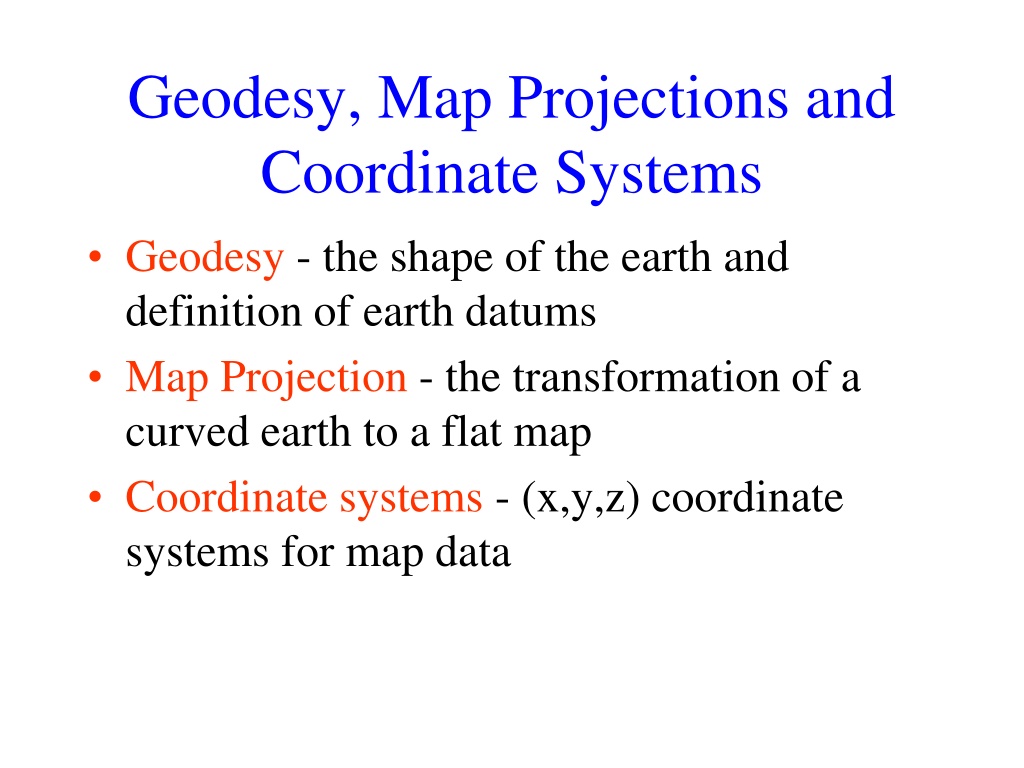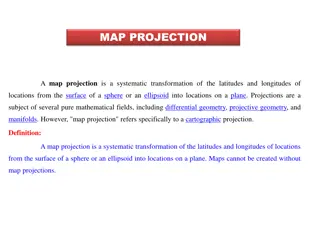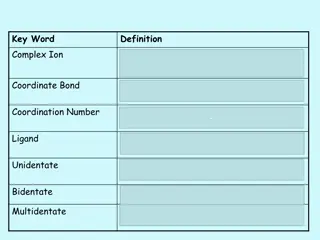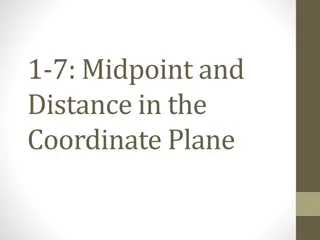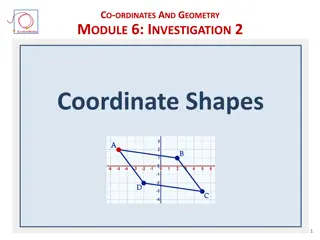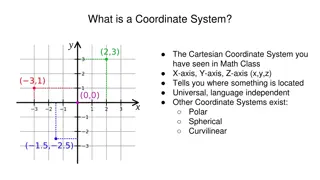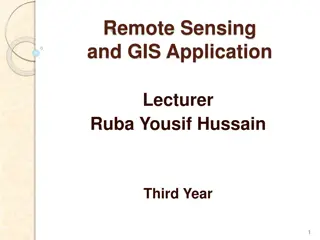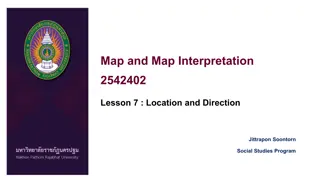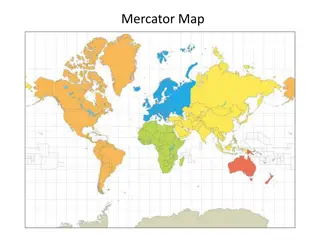Geodesy, Map Projections and Coordinate Systems
Delve into the world of geodesy, map projections, and coordinate systems, understanding the shape of the earth, various map projection techniques, and the significance of coordinate systems in spatial data analysis. Learn about spatial references in ArcMap, transforming between coordinate systems, and working with spatial references in GIS tools like ArcGIS.
Download Presentation

Please find below an Image/Link to download the presentation.
The content on the website is provided AS IS for your information and personal use only. It may not be sold, licensed, or shared on other websites without obtaining consent from the author.If you encounter any issues during the download, it is possible that the publisher has removed the file from their server.
You are allowed to download the files provided on this website for personal or commercial use, subject to the condition that they are used lawfully. All files are the property of their respective owners.
The content on the website is provided AS IS for your information and personal use only. It may not be sold, licensed, or shared on other websites without obtaining consent from the author.
E N D
Presentation Transcript
Geodesy, Map Projections and Coordinate Systems Geodesy - the shape of the earth and definition of earth datums Map Projection - the transformation of a curved earth to a flat map Coordinate systems - (x,y,z) coordinate systems for map data
Learning Objectives: By the end of this class you should be able to: describe the role of geodesy as a basis for earth datums list the basic types of map projection identify the properties of common map projections properly use the terminology of common coordinate systems use spatial references in ArcMap so that geographic data is properly displayed determine the spatial reference system associated with a feature class or data frame use ArcGIS to convert between coordinate systems calculate distances on a spherical earth and in a projected coordinate system
Readings: ArcGIS Desktop 9.3 Online Help Fundamentals of GIS http://webhelp.esri.com/arcgisdesktop/9.3/ind ex.cfm?TopicName=Three_views_of_GIS Map projections and coordinate systems http://webhelp.esri.com/arcgisdesktop/9.3/ind ex.cfm?TopicName=An_overview_of_map_p rojections
Spatial Reference = Datum + Projection + Coordinate system For consistent analysis the spatial reference of data sets should be the same. ArcGIS does projection on the fly so can display data with different spatial references properly if they are properly specified. ArcGIS terminology Define projection. Specify the projection for some data without changing the data. Project. Change the data from one projection to another.
Spatial References in action Data frame spatial reference used to display information in ArcMap used to define the scale for ArcMap displays including the legend scale bar inherited from the first layer added Feature class spatial reference underlies the coordinates that define feature locations used in projection on the fly to display data using the data frame spatial reference An example
Types of Coordinate Systems (1) Global Cartesian coordinates (x,y,z) for the whole earth (2) Geographic coordinates ( , z) (3) Projected coordinates (x, y, z) on a local area of the earth s surface The z-coordinate in (1) and (3) is defined geometrically; in (2) the z-coordinate is defined gravitationally
Global Cartesian Coordinates (x,y,z) Z Greenwich Meridian O Y X Equator
Global Positioning System (GPS) 24 satellites in orbit around the earth Each satellite is continuously transmitting a signal at speed of light, c GPS receiver measures time lapse, t, since signal left the satellite, r = c t Position obtained by intersection of radial distances, r, from each satellite Differential correction improves accuracy
Global Positioning using Satellites r2 r3 Number of Satellites 1 2 3 4 Object Defined Sphere Circle Two Points Single Point r4 r1
Geographic Coordinates ( , z) Latitude ( ) and Longitude ( ) defined using an ellipsoid, an ellipse rotated about an axis Elevation (z) defined using geoid, a surface of constant gravitational potential Earth datums define standard values of the ellipsoid and geoid
Shape of the Earth It is actually a spheroid, slightly larger in radius at the equator than at the poles We think of the earth as a sphere
Ellipse An ellipse is defined by: Focal length = Distance (F1, P, F2) is constant for all points on ellipse When = 0, ellipse = circle Z b O a X F1 F2 For the earth: Major axis, a = 6378 km Minor axis, b = 6357 km Flattening ratio, f = (a-b)/a ~ 1/300 P
Ellipsoid or Spheroid Rotate an ellipse around an axis Z b a O Y a X Rotational axis
Standard Ellipsoids Ellipsoid Major axis, a (m) Minor axis, b (m) Flattening ratio, f Clarke (1866) 6,378,206 6,356,584 1/294.98 GRS80 6,378,137 6,356,752 1/298.57 Ref: Snyder, Map Projections, A working manual, USGS Professional Paper 1395, p.12
Horizontal Earth Datums An earth datum is defined by an ellipse and an axis of rotation NAD27 (North American Datum of 1927) uses the Clarke (1866) ellipsoid on a non geocentric axis of rotation NAD83 (NAD,1983) uses the GRS80 ellipsoid on a geocentric axis of rotation WGS84 (World Geodetic System of 1984) uses GRS80, almost the same as NAD83
Definition of Latitude, m p S n O q r (1) Take a point S on the surface of the ellipsoid and define there the tangent plane, mn (2) Define the line pq through S and normal to the tangent plane (3) Angle pqr which this line makes with the equatorial plane is the latitude , of point S
Cutting Plane of a Meridian P Prime Meridian Equator Meridian
Definition of Longitude, = the angle between a cutting plane on the prime meridian and the cutting plane on the meridian through the point, P 180 E, W -150 150 -120 120 90 W (-90 ) 90 E (+90 ) P -60 -60 -30 30 0 E, W
Latitude and Longitude on a Sphere Meridian of longitude Z Greenwich meridian =0 N Parallel of latitude P - Geographic longitude - Geographic latitude E W O Y R R - Mean earth radius =0 Equator O - Geocenter X
Length on Meridians and Parallels (Lat, Long) = ( , ) Length on a Meridian: AB = Re (same for all latitudes) R D R C B Re Re Length on a Parallel: CD = R = Re Cos (varies with latitude) A
Example: What is the length of a 1 increment along on a meridian and on a parallel at 30N, 90W? Radius of the earth = 6370 km. Solution: A 1 angle has first to be converted to radians radians = 180 , so 1 = /180 = 3.1416/180 = 0.0175 radians For the meridian, L = Re = = km For the parallel, L = Re Cos Parallels converge as poles are approached = Cos = km
Curved Earth Distance (from A to B) Shortest distance is along a Great Circle Z A Great Circle is the intersection of a sphere with a plane going through its center. B A 1. Spherical coordinates converted to Cartesian coordinates. Y X 2. Vector dot product used to calculate angle from latitude and longitude 3. Great circle distance is R , where R=6370 km2 1 + R cos (sin sin cos cos cos( )) 1 2 1 2 1 2 Longley et al. (2001)
Representations of the Earth Mean Sea Level is a surface of constant gravitational potential called the Geoid Sea surface Ellipsoid Earth surface Geoid
Geoid and Ellipsoid Earth surface Ocean Geoid Gravity Anomaly Gravity anomaly is the elevation difference between a standard shape of the earth (ellipsoid) and a surface of constant gravitational potential (geoid)
Definition of Elevation Elevation Z P z = zp Land Surface z = 0 Mean Sea level = Geoid Elevation is measured from the Geoid
Vertical Earth Datums A vertical datum defines elevation, z NGVD29 (National Geodetic Vertical Datum of 1929) NAVD88 (North American Vertical Datum of 1988) takes into account a map of gravity anomalies between the ellipsoid and the geoid
Converting Vertical Datums Corps program Corpscon (not in ArcInfo) http://crunch.tec.army.mil/software/corpscon/corpscon.html Point file attributed with the elevation difference between NGVD 29 and NAVD 88 NGVD 29 terrain + adjustment = NAVD 88 terrain elevation
Geodesy and Map Projections Geodesy - the shape of the earth and definition of earth datums Map Projection - the transformation of a curved earth to a flat map Coordinate systems - (x,y) coordinate systems for map data
Earth to Globe to Map Map Projection: Map Scale: Scale Factor Representative Fraction Map distance Globe distance Globe distance Earth distance = = (e.g. 0.9996) (e.g. 1:24,000)
Geographic and Projected Coordinates ( ) (x, y) Map Projection
Types of Projections Conic (Albers Equal Area, Lambert Conformal Conic) - good for East-West land areas Cylindrical (Transverse Mercator) - good for North-South land areas Azimuthal (Lambert Azimuthal Equal Area) - good for global views
Conic Projections (Albers, Lambert)
Cylindrical Projections (Mercator) Transverse Oblique
Azimuthal (Lambert)
Projections Preserve Some Earth Properties Area - correct earth surface area (Albers Equal Area) important for mass balances Shape - local angles are shown correctly (Lambert Conformal Conic) Direction - all directions are shown correctly relative to the center (Lambert Azimuthal Equal Area) Distance - preserved along particular lines Some projections preserve two properties
Projection and Datum Two datasets can differ in both the projection and the datum, so it is important to know both for every dataset.
Geodesy and Map Projections Geodesy - the shape of the earth and definition of earth datums Map Projection - the transformation of a curved earth to a flat map Coordinate systems - (x,y) coordinate systems for map data
Coordinate Systems Universal Transverse Mercator (UTM) - a global system developed by the US Military Services State Plane Coordinate System - civilian system for defining legal boundaries Texas Centric Mapping System - a statewide coordinate system for Texas
Coordinate System A planar coordinate system is defined by a pair of orthogonal (x,y) axes drawn through an origin Y X Origin (xo,yo) ( o, o)
Universal Transverse Mercator Uses the Transverse Mercator projection Each zone has a Central Meridian ( o), zones are 6 wide, and go from pole to pole 60 zones cover the earth from East to West Reference Latitude ( o), is the equator (Xshift, Yshift) = (xo,yo) = (500000, 0) in the Northern Hemisphere, units are meters
UTM Zone 14 -99 -102 -96 6 Origin Equator -60 -90 -120
State Plane Coordinate System Defined for each State in the United States East-West States (e.g. Texas) use Lambert Conformal Conic, North-South States (e.g. California) use Transverse Mercator Texas has five zones (North, North Central, Central, South Central, South) to give accurate representation Greatest accuracy for local measurements
Texas Centric Mapping System Designed to give State-wide coverage of Texas without gaps Lambert Conformal Conic projection with standard parallels 1/6 from the top and 1/6 from bottom of the State Adapted to Albers equal area projection for working in hydrology
ArcGIS Spatial Reference Frames Defined for a feature dataset in ArcCatalog XY Coordinate System Projected Geographic Z Coordinate system Tolerance Resolution M Domain
